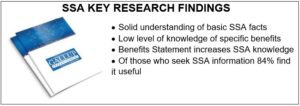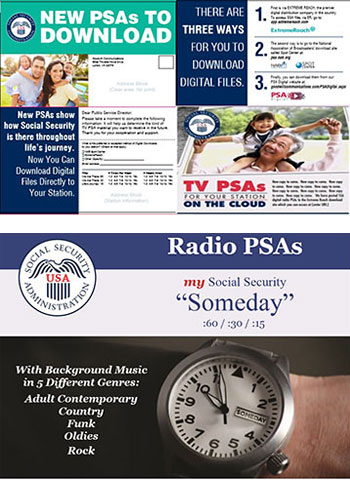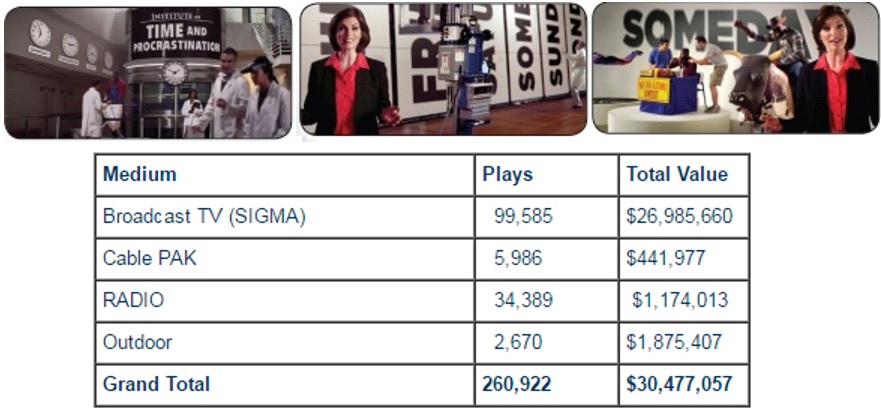
Baseline research, compelling creative messages, aggressive promotion and new media techniques help SSA reach their stakeholders.
To gain a better understanding of public perceptions about the social security issue, SSA launched a consumer research project conducted by the Gallup Corporation, titled: “Public Understanding Measurement System” (PUMS). The key findings of the survey are shown in the graphic.
 On a less positive note, the PUMS data indicates a reduced level of knowledge among several demographic groups, including those in the 30-49 age bracket, African-Americans and Asian-Americans. From the research, two things became clear:
On a less positive note, the PUMS data indicates a reduced level of knowledge among several demographic groups, including those in the 30-49 age bracket, African-Americans and Asian-Americans. From the research, two things became clear:
- SSA needs to do a better job of explaining the Benefits Statement
- Use that as a springboard to get the public to seek more information about their benefits.
One of the tools SSA used to accomplish these goals was to launch a series of multi-media PSA releases covering a variety of issues, ranging from the Supplemental Security Income program, to the Benefits Statement.
Goodwill Communications was retained to handle all post-production tasks for these campaigns.
Media/PSA Role
The PUMS study did not ask specifically what media the public uses to get information about Social Security. However, the data does show that knowledge levels about SSA are directly influenced by the receipt of the SSA Benefit Statement, and that became the topic of a television PSA entitled “Quiz Show.”
The goal of the PSA was to let Americans know they will receive a Benefits Statement on the anniversary of their birthday.

To frame the PSAs, a set was built to emulate the “Millionaire” TV program and the host of the program asks several questions that pertain to Social Security benefits, only one of which is the correct answer.
Distribution Plan
The SSA “Quiz Show” PSA distribution plan is typical of all the campaigns we have distributed on behalf of the Social Security Administration. It included, in terms of priority:
- Those stations that have used SSA PSAs previously
- Those stations that have not used SSA PSAs, but had the highest Previous Usage Index (PUI) which is the number of times they have used our other client PSAs
- Stations in all 212 top TV markets
- All English and Spanish networks, as well as; all local Spanish stations
- 500 major cable systems reached via our CablePAK distribution service
We also distributed the Quiz Show PSA via the National Association of Broadcasters’ closed circuit feed to member stations and to 5,000 radio stations.
Promotion/Collaboration
Several techniques were used to promote the “Quiz Show” campaign to internal and external audiences.
 First, the PSA was featured in CablePAK News, that accompanied PSAs sent to 500 leading cable systems as part of a “shared-reel” distribution.
First, the PSA was featured in CablePAK News, that accompanied PSAs sent to 500 leading cable systems as part of a “shared-reel” distribution.- Another newsletter produced by Goodwill Communications called Broadcasters Cafe had a feature on the PSA which was distributed to the top 1,100 broadcast stations that regularly use PSAs.
- The TV spot was converted into an “E-Mail PSA” to be sent to large institutions through their e-mail systems reaching employees at government agencies, corporations, and schools.
- It was also included in a package of PSAs pertaining to savings education distributed by another client, the American Savings Education Council. The Quiz Show PSA, which was part of this nine-PSA package, generated nearly $700,000 in value.
- We produced a banner ad jointly featuring SSA and ASEC, which was promoted to various websites, particularly those that reach consumers interested in financial education subjects.

Follow-up Campaigns
Subsequent PSA campaigns focused on a special website that SSA created called my Social Security which the public could access to see their benefits. We used similar promotional tactics to promote these campaigns, including an email campaign directed to media decision-makers and attractive packaging.
 For later SSA TV PSA campaigns we distributed them digitally via Extreme Reach, the premier platform for delivering programming assets to the media.
For later SSA TV PSA campaigns we distributed them digitally via Extreme Reach, the premier platform for delivering programming assets to the media.
To alert the media how and where they could download SSA PSAs, we developed attractive direct mailers which were sent to all stations.
For radio, we distributed SSA PSAs in five different genres which allowed stations to pick the ones that were most compatible with their program format.
Internal Promotion/Coordination
SSA has 125 SSA local public affairs specialists placed in ten offices around the country. To engage them in our PSA campaigns, we created:
- A portal website for posting distribution lists and evaluation reports, broken out by individual SSA region. Using these on-line reports, local SSA outreach staff could see which media outlets were and were not using their PSAs, and they had all the contact information they needed to make follow-up calls.
- A Webinar presentation which Bill Goodwill presented to the local Public Affairs Directors.
- To explain all these procedures and how they could be used, a unique Public Affairs Tool Kit was created and mailed to the Regional Communications Directors, and the SSA Public Affairs Specialists. The kit provided samples of all media materials distributed and instructions on how to access the SSA PSA reporting portal.
- We developed custom software that would break out SSA evaluation reports by regional office so the public affairs specialists could see the values for their particular part of the country.
 Reaching Young Movie Goers
Reaching Young Movie Goers
To try and reach younger audiences – many of whom do not believe Social Security benefits will be there for them when they retire, we coordinated a test of a SSA TV PSA in theaters located in five communities in the Washington, DC metropolitan area.
A total of 322 intercept surveys of moviegoers were conducted before the PSA was shown in theaters to assess baseline knowledge of key SSA copy points delivered in the PSA. On the last three days of a 28-day PSA test run, 310 interviews were completed to determine SSA knowledge of those same copy points.
The research showed that the percentage of moviegoers with correct responses to the five true/false survey statements increased from 47% before showing the PSA to 73% after exposure, a statistically significant improvement of 26 percent.

Expanding Media Tactics
Given an expanded budget we began including outdoor billboards in our media plan placing SSA PSA messages on highways, local thoroughfares an in inner city locations. To see a presentation on our placements, go to:
Evaluation Highlights
As we do with all our PSA campaigns, the Social Security PSA program was thoroughly evaluated. Following are the metrics for the Someday PSA campaign which promoted the my Social Security website.

Other Qualitative Usage Metrics
- One of the biggest misperceptions about PSAs is that most people think they air in the middle of the night when no one is watching. 73% of the SSA TV PSAs aired during the best dayparts from the last half of the Early Morning time frame to the first part of the Late Night daypart.
- Nearly two-thirds of all SSA TV PSA usage occurred in the top 100 markets, which is where 86% of all U.S. TV households are located.
- To provide clients with a way to compare their PSA against a standard, we have developed a benchmark comprised of evaluation data from 40 other national PSA campaigns launched by federal government clients. The SSA TV PSA exceeded the benchmark by 25%.
- Our evaluation software permits us to report usage by discrete geographic territories such as SSA Regions. By reporting data out this way, it shows where exposure is under the norm and the regions where local follow-up is needed.

Conclusion
Since we began working with the Social Security Administration, we have generated $256,435,392 in advertising equivalency value.
There is no question that PSAs have had a very significant impact on the ability of the Social Security Administration to reach its key audiences. While it is impossible to eliminate all non-PSA communications messages to determine the true impact of PSAs alone, suffice it to say that PSAs have unquestionably contributed to the nearly 60% of the American public which is “currently knowledgeable about SSA programs.”
For those who might be interested in the behind the scenes activity that went into making many of the SSA TV PSAs, you can view them at: http://www.youtube.com/watch?v=HzMa0wCCQ6Q

